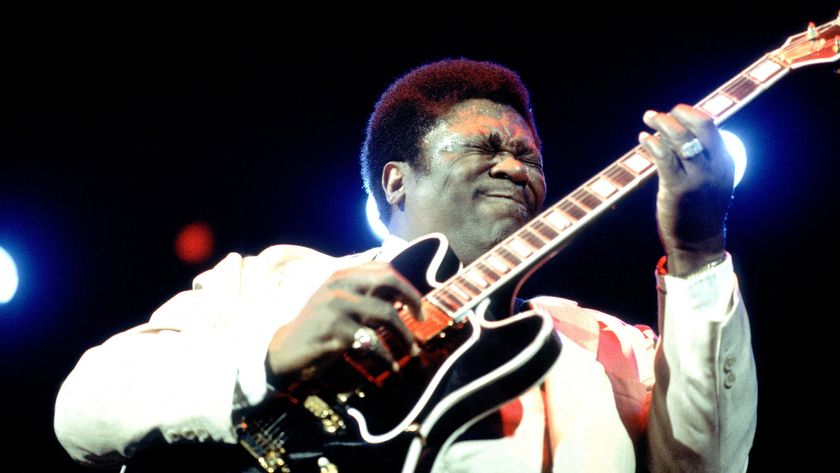“We asked Troy to come up with six of his favourite ‘next level’ slide licks – and he went for a challenging 7/8 time feel and open E tuning”: Troy Redfern is an innovative slide maestro – and his licks will up your solo game
Armed with his custom Fender Stratocaster, Redfern walks us through his signature slide style, and how he accentuates the underlying chord to bring out the melody

Troy Refern has developed a unique and versatile slide style. We asked Troy to come up with six of his favourite ‘next level’ slide licks and he went for a challenging 7/8 time feel and classic open E tuning (E-B-E-G#-B-E). All the examples combine classic blues-rock slide vocabulary but framed in this more sophisticated odd time setting. But first let’s review the basics of good slide technique.
Learning slide has a couple of barriers to entry. The first is establishing consistent contact between the slide and the strings. You may find using heavier strings and a higher action can help here. Troy uses a super-sized, heavy brass slide, which provides a great tone and sustain, but can be hard to control if you are just starting out. So feel free to experiment with using a lighter slide, perhaps glass, if you need to.
The second barrier is good intonation, and for this it is essential to place the slide directly over the desired fret(wire). Good intonation requires practice so take it slowly at first and get used to placing the slide properly in position.
Once the intonation is dialled in it’s time to address the third barrier, which is to be able to mute unwanted strings from ringing, both behind and in front of the slide. Troy uses a fingerstyle technique for all but one of the examples here.
The picking fingers rest on the strings to mute them and remain poised, ready to pluck other strings when required. He also mutes the strings with his picking-hand heel when using the pick. Generally we’d advise a fingerstyle picking approach, as it’s easier to keep it all under control.
The most popular fingers for the slide are the second, third and fourth digits. But there’s is no right or wrong here and the best policy is to go with what feels best to you. Troy places the slide on his fourth finger, which allows other fretting fingers to be used behind it. The fretting-hand’s first, second and third fingers can be laid lightly on the strings behind the slide to stop any unwanted noise.
The final technique to work on is sliding into notes and adding vibrato. These are the two articulations that help to give slide guitar playing its distinctive sound and character. You can practice sliding in both from below and above the target tone. Another classic trick Troy uses is to fall off the notes at the end of the phrase, and a downward slide helps to provide a bit of theatre to the end of the phrase.
Adding vibrato with a slide can take a bit of practice. The vibrato comes from moving the slide back and forth across the target fret. This makes the note go slightly flat and slightly sharp. Troy uses a variety of vibrato types from slow and soulfull to fast and aggressive. The key thing is for the vibrato you choose to be consistent in both rate and width.
The phrases in our examples are tasteful and well chosen, and learning them will give plenty of scope to apply the techniques outlined above. The phrasing is pretty advanced due to the 7/8 time signature so learning this feel will test the ability of the most seasoned of slide players.
If you are new to slide guitar we’d recommended using one of the simple ideas that Troy plays to start with, and playing it in 4/4. This will free up a bit headspace to concentrate on nailing the intonation and string muting.
As usual the notation contains all of the articulations and phrasing from the video performances. It’d be well worth taking a close look at the way Troy fingerpicks the strings and and phrases his licks in the video. Hopefully there will be a new technique, lick or phrase in here for you to perfect. If you find one you like, then you can tweak it to suit your taste, and use it in future solos.
Once you have mastered some of the phrases in Troy’s examples aim to explore them further with your own riffing and soloing. Often, it’s when you start improvising after being inspired by playing like this, that you’ll really notice a development in your own playing. Have fun with improving your slide chops!
Get the tone
Amp Settings: Gain 6, Bass 6, Middle, 7, Treble, 7, Reverb 4
For this recording, Troy used his Fender Stratocaster. The bridge pickup was selected, and the tone and volume controls set to taste. Any electric guitar will work well for this month’s performance, just dial up a dynamic overdriven tone. A bit of reverb or delay can of course be added for that professional touch.
Technique Focus: Open E tuning (E-B-E-G#-B-E)
Open E tuning sounds great with a slide. When the slide is placed over any fret the corresponding major chord can be played with no need for tricky angling. It also sounds great to slide in and out of any of the notes.
To retune your guitar, raise the fifth and fourth strings a tone (from A-B and D-E), and the third string a semitone (G-G#). A hardtail guitar such as an acoustic, Telecaster or Les Paul style is a great choice as the tuning will hold straight away.
If you are using an electric guitar with a vibrato unit then you may need a little patience when you tune to a chord, as it might take several re-tunes for a floating bridge to settle. But the results are musically exciting, and they can sound mighty impressive, too.
Examples 1-4
Example 1. For this first example Troy is phrasing around the open E7 chord. Notice how he’s using the slide to glide into and out of any of the notes at the 12th fret. Sliding in and out of the major third (G#) is particularly effective, as it brings out the chord’s inherently ‘major’ sound.
Example 2. Troy’s second example features a classic, raspy blues riff on the bottom three strings and places it in 7/8 time. The notes can be plucked and stopped (muted) by the picking hand. We have also marked where Troy fingers the 3rd fret of the fifth string instead of using the slide.
Example 3. Here, Troy expands on the ideas from Example 2. This time he employs the pick to strum the strings which provides more attack than playing with the fingers. The strummed top strings provide sonic contrast and again there are a few fretted notes to navigate.
Example 4. In this example, Troy expands the sonic palette by including the 7th position (B) and the 10th position (D) chords. Again he uses the pick so the string muting is taken care of with the palm of the same hand (remember to flatten the spare fretting-hand fingers on the strings, too).
Examples 5-8
Example 5. For this example, Troy builds on all the ideas and themes he’s looked at so far. He also introduces some single-note lines into the mix. These single notes provide contrast with the the chords and this is a classic slide guitar trick that’s particularly effective.
Example 6. To finish off, Troy treats us to something a little more mellow. Fingerstyle technique is a great way to pick out double-stops on non-adjacent strings, and when playing these licks the other strings will need to be damped. This is achieved by resting the picking-hand fingers on any strings that aren’t being used.
Get The Pick Newsletter
All the latest guitar news, interviews, lessons, reviews, deals and more, direct to your inbox!
Jon Bishop is a UK-based guitarist and freelance musician, and a longtime contributor to Guitar Techniques and Total Guitar. He's a graduate of the Academy of Contemporary Music in Guildford and is touring and recording guitarist for British rock 'n' roll royalty Shakin’ Stevens.

“A lot of guitarists who can play killer leads get real sterile on their rhythm stuff – they’re all too careful about playing their chords dead straight”: Dimebag Darrell wrote 42 lesson columns for Guitar World. Here’s the best advice he shared

It’s a soloing strategy that T-Bone Walker, B.B. King and Albert King all used, and will instantly make your blues solos sound more pro – learn parallel pentatonics and you will set your playing free
Most Popular












